Cliff's Notes Oct 21, 2021
- Blog
- Cliff's Notes Oct 21, 2021
.png)
Cliff's Notes Oct 21, 2021
- By CWG Advisors
- October 21, 2021
- 0
Thursday, October 7, 2021
“Let go of knowledge and opinions that are no longer serving you well and anchor your sense of self in flexibility rather than consistency.”
Think Again: The Power of Knowing What you don’t Know - Adam Grant
|
Key Takeaways: After a brief 6% correction in the S&P 500, it appears the markets are headed back toward all-time highs. Currently investors face a conundrum, the juxtaposition between bullish short-term dynamics and longer-term headwinds. In the short-term strong earnings, positive seasonality, and the unleashing of corporate buybacks could buoy markets into year-end. Longer-term headwinds such as valuations, the transition out of the early cycle recovery phase to mid-cycle economy, and the Fed tightening monetary policy has us more cautionary. Flexibility is paramount in this market environment and those investors who can participate in the rising trend while keeping an eye on the proverbial exit will be rewarded. |
In our last letter to clients over the summer, we wrote the following:
“In our view the time has come to take down some risk. In practice, that means lightening up on some higher-beta holdings and keeping higher-than-normal levels of cash on hand to take advantage of any market weakness. We do not believe that the next correction will be “the Big One” but perhaps a more run-of-the-mill pullback of 10-20% (still scary in real-time) which we’d use as an opportunity to leg back in. Risk management is core to what we do; we will always put a premium on protecting our clients hard-earned wealth. If this means missing out on the last few potential points to the upside, so be it.”
As we sit here mid-October, this view largely played out, as the S&P 500 experienced a nearly 6% correction from late-September to early-October. Where we were off was on the timing and the potential magnitude of the pullback. It took longer to materialize than we thought and was more shallow. This period has been unique, as the chart below highlights.
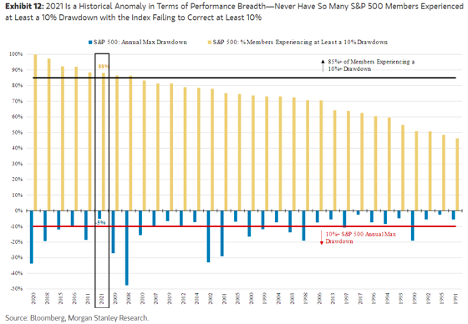
During the most recent pullback, 88% of the stocks in the S&P 500 experienced at least a 10% correction, while the overall market remained buoyant. In fact, more stocks fell by 10% or more than in 2008 when the market was cut in half! Truly interesting times!
While it appears that the latest pullback may be behind us for the time being, we still believe that the market may be on borrowed time before a more drastic bout of volatility hits. The concerns we cited over the summer have not gone away. Currently investors face a conundrum between the shorter-term bullish signals; strong earnings, year-end seasonal strength, corporate buybacks, and more intermediate-term headwinds; over-valued markets, the transition to mid-cycle in the economy, and the Fed embarking on a tightening cycle. We’ll briefly review each of these. Flexibility will be key in navigating the markets over the coming months.
Investment Implications (Short-term)
Earnings: Third-quarter earnings season is just getting underway, and expectations are for earnings growth of nearly 30% from the same quarter last year. As of the time of this writing, 53 companies, about 10% of the S&P 500, have reported Q3 earnings. Results have been strong, with companies beating expectations by 13% so far, reporting earnings growth of 34% year over year. (Bloomberg) More importantly, the market continues to largely downplay concerns over supply chains and inflation. Many of the most important stocks to the index will report in the next 2 weeks, so we’ll be watching these results and management commentary very closely.
Seasonality: The chart below, courtesy of EquityClock.com, looks at the average return of the S&P 500 from a calendar perspective going back 20 years. We’ve looked at data going back to 1928 as well which confirms the same seasonal pattern. What we see is that on average, the fourth quarter is the strongest part of the year. There is certainly no guarantee that the market will follow this path in any given year (see 4Q 2018 as a recent example) but nonetheless many market participants expect this pattern to play out. If investors then collectively act to get in front of the perceived strength, the result may very well manifest in a self-fulfilling prophecy giving way to a year-end rally followed by weakness in early 2022.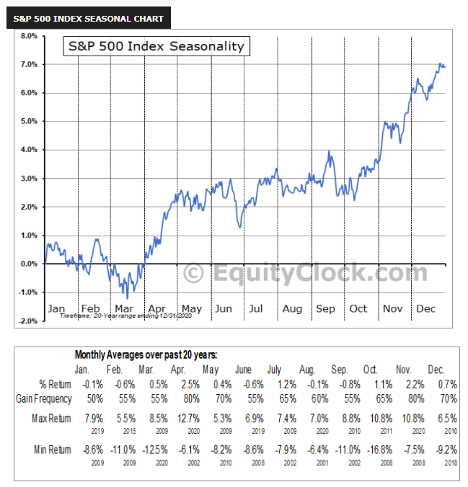
Source: https://charts.equityclock.com/sp-500-index-seasonal-chart
Buybacks: Through early-October 2021 we’ve seen the largest authorization of stock buybacks in history, totally nearly $1 trillion. In fact, according to the Goldman Sachs Buyback desk, expectations for 4Q are that buyback activity will amount to $3.8 billion per trading day, for a total of $230 bn over the quarter. The buyback window opens as earnings season draws to a close, so much of the activity will be concentrated in November and December. Any selling pressure will likely be supported through year-end by the corporate bid.
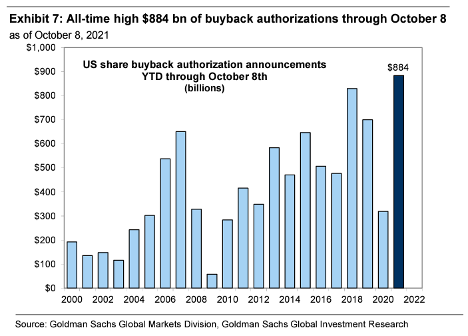
While the outlook appears sanguine over the final months of 2021, as we look toward 2022 we expect the path forward to be more challenging. Investors must contend with sky-high valuations in both equities and fixed income, a potential peak in the macroeconomic cycle, and a Fed embarking on a tightening cycle.
Investment Implications (Longer-term)
Valuation: At the risk of beating a dead horse, we will again highlight just how extreme valuations are in the equity and fixed income markets. As we’ve discussed, valuation is never a catalyst, and is almost meaningless over the short-term. Likewise, markets may defy gravity for a time and remain over-valued for a lot longer than logic would dictate. What is also true however, is that over the long-term it is only valuation and the fundamentals that matter. Here the key takeaway is that investors need to ratchet down return expectations going forward until valuations reset and interest rates normalize.
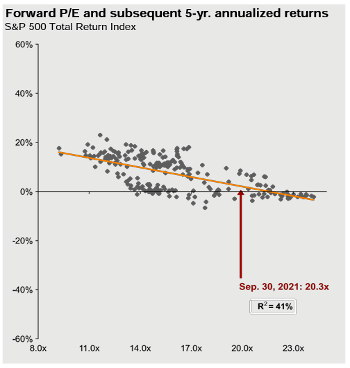
Source: JP Morgan Guide to the Markets. September 30, 2021
(Note – as of October 19, we’re now at 22.3x forward P/E indicating an expected return of 0% over the next 5 years.)
Macro Cycle: As clients and readers know we track the macroeconomic cycle in two ways. The traditional business cycle pattern of recovery, expansion, moderation and contraction/recession govern our longer-term market views. This business cycle unfurls slowly over a period of 7-10 years but is extremely impactful at inflections. To navigate the nuances more tactically, we rely on the Quad framework, which measure the rates of change in growth and inflation. The Quads help us from a risk budgeting standpoint, ie how much relative risk we want to have on or take off, and from a sector and factor based standpoint guiding overweighting and underweighting decisions.
From a business cycle perspective, the economy is clearly transitioning out of the early-cycle recovery phase, driven by massive levels of fiscal and monetary stimulus, into more of a mid-cycle peaking phase. Traditionally the mid-cycle phase tends to be the longest lasting (nearly 4 years on average) and is the phase when most stock market corrections have taken place, as early cycle exuberance fades and expectations readjust. Sector leadership rotates frequently, making manager and stock selection all the more important.
The current Quad map view currently reflects mid-cycle dynamics as well, as the forecasts for growth and inflation during forthcoming quarters remain near the origin, lowering overall conviction for sector and style factor bets. The main implication for our portfolios in this environment is that we tend to decrease our relative sector and factor overweights and underweights relative to the market until our intermarket signals provide more clarity.
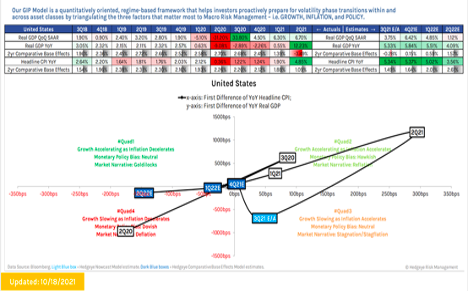
Source: Hedgeye
In looking at the Quad map above, we will draw our reader’s attention to 2Q22 which at this point is more decisively tilting toward QUAD 4, where both growth and inflation decelerate simultaneously. This time period has our attention as the next potential pivot point for a meaningful correction. Since markets are discounting mechanisms, we would anticipate that the market may price in this regime change during 1Q. Combine the Quad view with (1) weak seasonality, (2) transition to mid-cycle economy and (3) the Fed tightening monetary conditions, and what we’re left with is not a cocktail conducive for risk assets. At this point however, it’s much too early to begin to prepare for potential volatility, but it is worth monitoring over the coming months.
The Fed: Much has been written lately about the Federal Reserve and the upcoming tapering announcement, which we anticipate at the November FOMC (Federal Open Market Committee) meeting. This is important due to the psychological linkage between the Fed and the financial markets. Liquidity and volatility have an inverse relationship. Tapering reduces the amount of liquidity via less bond-buying, but also signals a forewarning of tighter monetary policy to come.
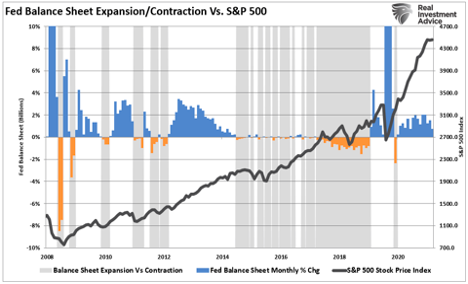 Source: Bloomberg
Source: Bloomberg
In practice tapering could also impact longer term interest rates as the increased supply of treasuries may require a higher interest rate to clear the market. Since the risk-free rate is the bedrock of finance, higher interest rates may cause valuations to compress. Any commentary around the pace and timeline of the taper could have an effect on markets as well.
For now, we remain optimistic about the markets due to continued strength in earnings, seasonality, and liquidity. However, we remain concerned about the broader macro risks, which keep us cautionary longer term. This market environment will require flexibility above all as calm eddies in the short term may give way to roaring rapids further downstream.
Thanks for reading my note.
Cheers,
Cliff
Disclosures:
Listed market indices are provided for information purposes only and are not intended in any way to be representative of Cornerstone Wealth Group’s client accounts or performance. The holdings and performance of Cornerstone Wealth Group’s client accounts may differ substantially from the listed indices. Market indices are unmanage and are not available for direct investment.
The S&P 500 Index, or the Standard & Poor's 500 Index, is a market-capitalization-weighted index of the 500 largest publicly-traded companies in the U.S. It is not an exact list of the top 500 U.S. companies by market capitalization because there are other criteria to be included in the index. The index is widely regarded as the best gauge of large-cap U.S. equities.
This material provided by Cornerstone Wealth Group is for informational purposes only. It is not intended to serve as personalized investment advice or as a recommendation or solicitation of any particular security, strategy or investment. Any securities mentioned herein are not to be taken as advice or recommendation to buy or sell a specific security. The information provided may not be applicable to your account managed by Cornerstone Wealth Group. Please contact Cornerstone Wealth Group for specific information regarding the holdings and trading activity of your account. Opinions expressed in this commentary do not represent a personalized recommendation of a particular investment strategy to you. Additionally, you should review and consider any recent market news. All expressions of opinion are subject to change without notice in reaction to shifting market or other conditions. Data provided is believed to be accurate, but its accuracy, completeness or reliability cannot be guaranteed.
Investment advisory services offered through Cornerstone Wealth Group, LLC dba Cornerstone Wealth, an SEC registered investment adviser. Custody and other brokerage services provided to clients of Cornerstone Wealth Group, LLC dba Cornerstone Wealth are offered by Fidelity Brokerage Services LLC, Member NYSE/SIPC and Charles Schwab & Co., Inc., Member FINRA/SIPC.
Securities offered through Mutual Securities, Inc., Member FINRA/SIPC. Supervisory office located at 16810 Kenton Drive, Suite 200, Huntersville, NC 28078. Cornerstone Wealth Group, LLC dba Cornerstone Wealth is not affiliated with Mutual Securities, Inc.
Appropriate Checklist for Year-End Tax Planning
Navigating Market Volatility: A Note from Cliff Hodge, CFA
Contact Info
- Phone:704-987-3410
- Email: info@cwgadvisors.com
Web: cwgadvisors.com




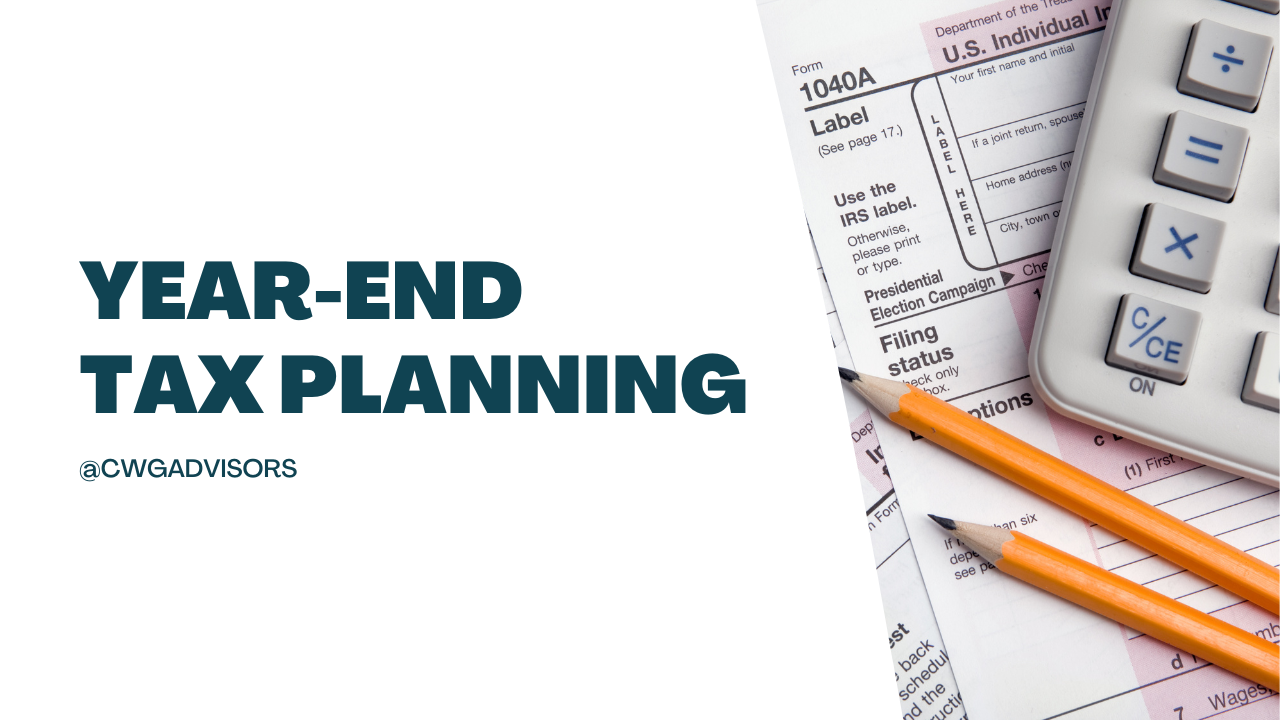
.png)


.png?width=180&height=138&name=Orange%20Bold%20Business%20Steps%20YouTube%20Thumbnail%20(1).png)